Entry Database : PDB / ID : 2a2xTitle Orally Active Thrombin Inhibitors in Complex with Thrombin Inh12 Thrombin heavy chain Thrombin light chain synthetic peptide Keywords / / / Function / homology Function Domain/homology Component
/ / / / / / / / / / / / / / / / / / / / / / / / / / / / / / / / / / / / / / / / / / / / / / / / / / / / / / / / / / / / / / / / / / / / / / / / / / / / / / / / / / / / / / / / / / / / / / / / / / / / / / / / / / / / / / / / / Biological species Homo sapiens (human)Synthetic (others) Method / / Resolution : 2.44 Å Authors Lange, U.E.W. / Baucke, D. / Hornberger, W. / Mack, H. / Seitz, W. / Hoeffken, H.W. Journal : BIOORG.MED.CHEM.LETT. / Year : 2006Title : Orally active thrombin inhibitors. Part 2: optimization of the P2-moietyAuthors : Lange, U.E.W. / Baucke, D. / Hornberger, W. / Mack, H. / Seitz, W. / Hoeffken, H.W. History Deposition Jun 23, 2005 Deposition site / Processing site Revision 1.0 Nov 14, 2006 Provider / Type Revision 1.1 Apr 30, 2008 Group Revision 1.2 Jul 13, 2011 Group Atomic model / Database references ... Atomic model / Database references / Derived calculations / Non-polymer description / Structure summary / Version format compliance Revision 1.3 Dec 12, 2012 Group Revision 1.4 Oct 11, 2017 Group / Category / Item Revision 1.5 Apr 4, 2018 Group / Category / Item Revision 1.6 Aug 23, 2023 Group Data collection / Database references ... Data collection / Database references / Derived calculations / Refinement description / Structure summary Category chem_comp / chem_comp_atom ... chem_comp / chem_comp_atom / chem_comp_bond / database_2 / pdbx_initial_refinement_model / struct_conn / struct_site Item _chem_comp.pdbx_synonyms / _database_2.pdbx_DOI ... _chem_comp.pdbx_synonyms / _database_2.pdbx_DOI / _database_2.pdbx_database_accession / _struct_conn.pdbx_leaving_atom_flag / _struct_site.pdbx_auth_asym_id / _struct_site.pdbx_auth_comp_id / _struct_site.pdbx_auth_seq_id
Show all Show less
 Open data
Open data Basic information
Basic information Components
Components Keywords
Keywords Function and homology information
Function and homology information Homo sapiens (human)
Homo sapiens (human) X-RAY DIFFRACTION /
X-RAY DIFFRACTION /  MOLECULAR REPLACEMENT / Resolution: 2.44 Å
MOLECULAR REPLACEMENT / Resolution: 2.44 Å  Authors
Authors Citation
Citation Journal: BIOORG.MED.CHEM.LETT. / Year: 2006
Journal: BIOORG.MED.CHEM.LETT. / Year: 2006 Structure visualization
Structure visualization Molmil
Molmil Jmol/JSmol
Jmol/JSmol Downloads & links
Downloads & links Download
Download 2a2x.cif.gz
2a2x.cif.gz PDBx/mmCIF format
PDBx/mmCIF format pdb2a2x.ent.gz
pdb2a2x.ent.gz PDB format
PDB format 2a2x.json.gz
2a2x.json.gz PDBx/mmJSON format
PDBx/mmJSON format Other downloads
Other downloads 2a2x_validation.pdf.gz
2a2x_validation.pdf.gz wwPDB validaton report
wwPDB validaton report 2a2x_full_validation.pdf.gz
2a2x_full_validation.pdf.gz 2a2x_validation.xml.gz
2a2x_validation.xml.gz 2a2x_validation.cif.gz
2a2x_validation.cif.gz https://data.pdbj.org/pub/pdb/validation_reports/a2/2a2x
https://data.pdbj.org/pub/pdb/validation_reports/a2/2a2x ftp://data.pdbj.org/pub/pdb/validation_reports/a2/2a2x
ftp://data.pdbj.org/pub/pdb/validation_reports/a2/2a2x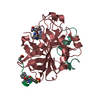
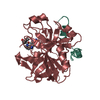
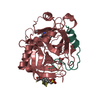
 Links
Links Assembly
Assembly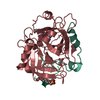

 Components
Components Homo sapiens (human) / References: UniProt: P00734
Homo sapiens (human) / References: UniProt: P00734 Homo sapiens (human) / References: UniProt: P00734, thrombin
Homo sapiens (human) / References: UniProt: P00734, thrombin X-RAY DIFFRACTION / Number of used crystals: 1
X-RAY DIFFRACTION / Number of used crystals: 1  Sample preparation
Sample preparation ROTATING ANODE / Type: RIGAKU RU200 / Wavelength: 1.5418 Å
ROTATING ANODE / Type: RIGAKU RU200 / Wavelength: 1.5418 Å Processing
Processing MOLECULAR REPLACEMENT
MOLECULAR REPLACEMENT Movie
Movie Controller
Controller



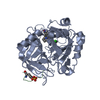
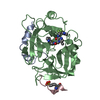
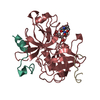
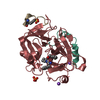
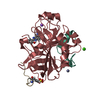

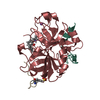
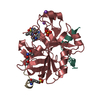
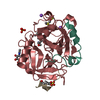
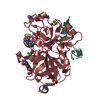
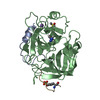
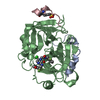
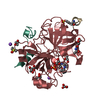
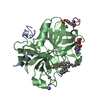
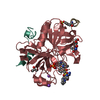
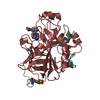
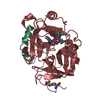
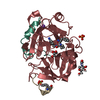
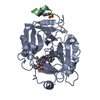
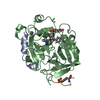
 PDBj
PDBj













